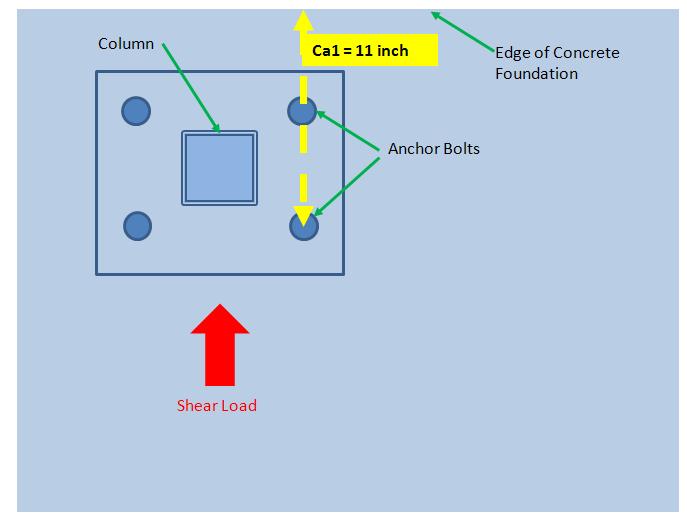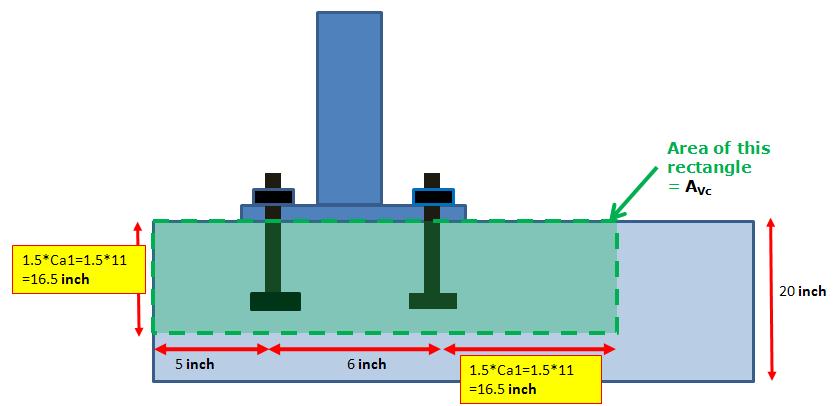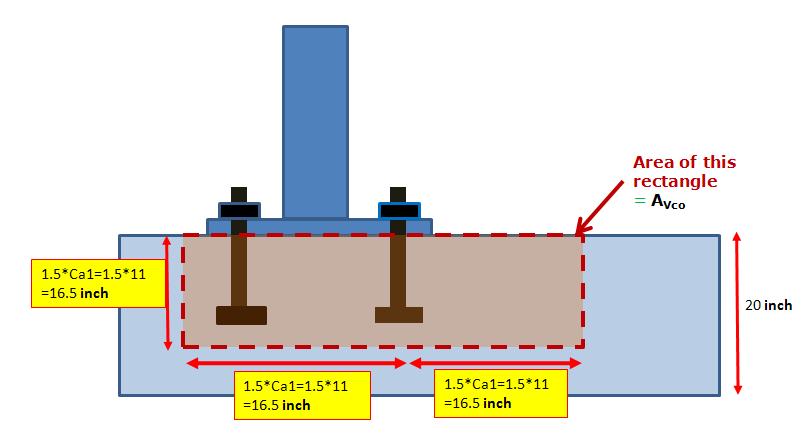Before diving into the concrete anchor bolt design calculation example for calculating anchor breakout strength in shear, please go through the problem statement and part-1, part-2, part-3, part-4 and part-5 of this series. The calculation exercise is carried out according to the ACI 318 appendix D codes.
Calculation
The code gives the following formula for finding out the break out strength in shear for a group of anchor bolts:
φVcbg= φ(AVc/AVco)ψec,V ψed,V ψc,V ψcp,VVb……………………………..D-22
Where,
Φ – Strength reduction factor for breakout strength and its value for non-reinforcement in tension is 0.70
Avc – projected concrete failure area of the group of anchors, for calculation of strength in shear (in inch2) as approximated by a rectangle with edges bounded by 1.5*Ca1 (1.5*5 = 7.5 inch in our case) and the free edges of the concrete from the centerline of the anchors. We will calculate it little later.
Ca1 – Distance from the center of an anchor shaft to the edge of concrete in one direction (in inch). Refer Fig.1 below.
Avco – Total projected shear failure area approximated by a square bounded by 1.5*Ca1 (1.5*5 = 7.5 inch in our case) from the centerline of a anchor at all the sides. We will calculate it little later.
ψec,V – Modification factor for the anchor group loaded eccentrically in shear, in our case there is no eccentric loading , so ψec,V=1.
ψed,V – Modification factor for edge effect for the anchor group in shear, we will calculate it later.
Ψc,V – Modification factor based on the presence and absence of crack in the concrete, in our case value of it = 1..
ψcp,V – Modification factor for post weld types of anchor. For cast in place anchor ψcp,V = 1
Vb – Basic concrete break out strength for a single anchor in shear, we will calculate it later.
Calculation of AVc


Refer the above two figure (Fig.1 and Fig.2), it should be clear by now that
AVC = 16.5*(5+6+16.5) = 453.75 inch2
Calculation of AVco

By referring the above figure (Fig.3), we can calculate
Avco= 16.5*(16.5+16.5) = 544.5 inch2
Calculation of ψed,V
For Ca2 <1.5 Ca1
ψed,V = 0.7+(0.3*Ca2)/(1.5*Ca1) = 0.7+ (0.3*5)/(1.5*11) = 0.79
Where,
Ca2 – Minimum concrete edge distance from anchor perpendicular to Ca1.
Calculation of Vb
Vb=(7*√da*[le/da]0.2 )*λ*√f’c*(Ca1)1.5 ………………………..D-24
Where,
da = Diameter of the anchor bolt in inch., in our case it is 0.75 inch. Remember we have started with the 0.75 inch anchor in the part-1 of this calculation.
le = Length of the anchor inserted inside the concrete in inch. In our case it is 10 inch.
λ = A factor related to the reduced mechanical properties of concrete, for normal weight concrete λ=1.
Ca1 = we already know it from the Fig.1. Its value is 11 inch.
fc’ = Specified compressive strength of the concrete, in our case fc’=4000 psi (refer problem statement of part-1).
So, by putting all the values, the above equation (D-24) becomes
Vb = (7*√0.75*[10/0.75]0.2)*1*(√4000)*111.5
= 23482.02 lb
Now, from the equation D-22, after putting all the values at right hand side,
φVcbg = φ(AVc/AVco)ψec,V ψed,V ψc,V ψcp,VVb
= 0.7*(453.75/544.5)*1*0.79*1*1*23482.02 lb
= 10821.297 lb
The concrete break out strength in shear for the anchor bolt group according to the ACI codes is calculated as 10821.297 lb. The next part (Part-7) will talk about Concrete Pullout Strength in Shear.
Hi, I am Shibashis, a blogger by passion and an engineer by profession. I have written most of the articles for mechGuru.com. For more than a decades i am closely associated with the engineering design/manufacturing simulation technologies. I am a self taught code hobbyist, presently in love with Python (Open CV / ML / Data Science /AWS -3000+ lines, 400+ hrs. )

nyc job
bt i guess there is some prob with the area calculated for shear for group of anchor..
there should be 35 degree leverage to the edge…